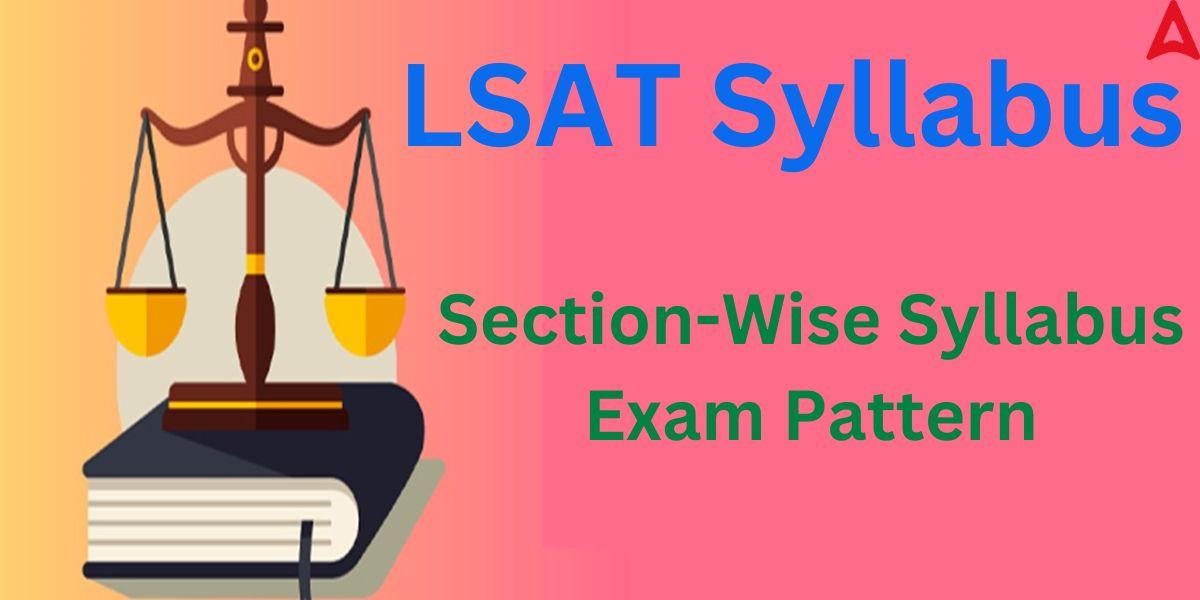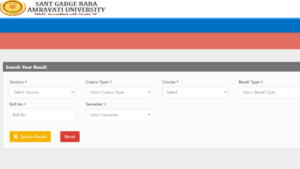LSAT Syllabus: The LSAT syllabus is important for every law aspirant going to attempt LSAT as it gives a detailed description of the topics that may be asked in this competitive exam. The Law School Admission Test (LSAT) is a common standardized exam for admission to law schools in several nations. The Law School Admission Council (LSAC) administers the LSAT, which is renowned for its distinct method of evaluating applicants’ abilities and aptitude for legal studies. This article will examine the LSAT syllabus in detail, offering insights into the specific subject matter covered in each segment as well as the exam pattern of the test.
LSAT Syllabus
Reading comprehension, logical reasoning, and analytical reasoning are tested in the LSAT syllabus’s questions. The Law School Admission Council (LSAC), a US-based organization, administers the LSAT exam, which is based on these subjects. The logical reasoning section consist of two parts, thus diving the examination in total 4 sections. LSAT syllabus contains questions from all the 4 sections stated above. Thus, in order to pass this exam, students need to finish the LSAT Syllabus 2024 and hone their logical and critical thinking abilities. Critical thinking, analytical reasoning, logical reasoning, and reading comprehension are all assessed in the LSAT; these abilities are necessary for success in law school. The test is divided into multiple portions, each of which evaluates the candidate’s skills in a certain way.
LSAT Overview
LSAT is an international-level law exam conducted by the US-based LSAC (Law School Admission Council). This test is used to admit students into prestigious law schools across the globe. The overview of the exam is given below.
| LSAT Highlights | |
| Particulars | Details |
| Exam Name | LSAT |
| Full Name | Law School Admission Test |
| Frequency | Twice a Year |
| Exam Month | January and May |
| Conducted by | Law School Admission Council (LSAC) |
| Examination Mode | Online |
| Language | English |
| Question Type | Objective Type Questions (MCQs) |
LSAT Syllabus India
The Law School Admission Council (LSAC) formulates and releases the LSAT India 2024 syllabus. LSAC Global has released the LSAT India 2024 syllabus for the tests scheduled for the January and May sessions. Topics from each subject covered in the question paper, such as reading comprehension, analytical reasoning, logical reasoning 1, and logical reasoning 2, are mentioned in the syllabus. There will be roughly 22–23 questions in each section. All applicants to the LSAT India must be aware of and consult the LSAT India syllabus 2024 in order to adequately prepare for the exam. The detailed LSAT syllabus for India is given below.
| Logical Reasoning | Analytical Reasoning | Reading Comprehension |
| Number Series | Arrangements | Law |
| Letter Series | Comparisons | Sociology |
| Calendars | Selections | Physiology |
| Clocks | Family Based Problems | Psychology |
| Cubes | Intersection Type | Technology |
| Venn Diagrams | Logical Deductions | Economics |
| Binary Logic | Directions | Business |
| Logical Sequence | Coding & Decoding | Politics |
| Logical Matching | Literature | |
| Logical Connectives | Judiciary | |
| Syllogism | ||
| Blood Relations |
LSAT Syllabus UG
The first step in pursuing a five-year, three-year, or LLM program at a prominent college is to familiarize yourself with the LSAT 2024 syllabus. The LSAT UG syllabus tests the high-level informal reasoning, reading, and deductive reasoning skills of a candidate. The syllabus for the LSAT UG is given in a detailed manner below.
Analytical Reasoning
The LSAT UG syllabus has always included Analytical Reasoning. The focus of this section of the LSAT UG 2024 exam relies on your capacity to comprehend and evaluate intricate connections between several components. It’s frequently referred to as the “Logic Games” section. Here are some crucial details to be aware of this section syllabus:
- Your ability to reason logically is tested in the section on analytical reasoning.
- You will be asked to respond to questions based on a set of guidelines or requirements.
- Usually, the questions ask you to arrange or categorize items according to predetermined standards.
- Your goal is to use the information provided to draw conclusions and deductions and to solve the puzzles.
- The ability to diagram and comprehend the rules are essential for this section.
- It’s crucial to practice playing various logic games and finding quick solutions.
- You’ll be able to create successful tactics and get used to the section’s format with regular practice.
- Raising your overall LSAT India score will be facilitated by improving your Analytical Reasoning performance.
Logical Reasoning
A significant component of the LSAT 2024 exam is the Logical Reasoning segment. It assesses your capacity to evaluate claims, identify logical fallacies in reasoning, and reach logical conclusions. You will read brief texts in this part and respond to questions based on them. There are two sections in logical reasoning (1& 2). This section contains questions about recognizing the weaknesses in an argument, reasoning by analogy, and applying principles. The questions come in a variety of forms, including:
- Argument strengthening or weakening: You must select the response options that either support or refute the provided argument in these questions.
- Identification of underlying assumptions: You will be required to ascertain the underlying assumptions that the argument must hold.
- Flaw Identification: Finding the logical inconsistencies or flaws in the argument is the primary nature of these questions.
- Inference and conclusion drawing: Using the information in the passage, you must draw logical inferences or conclusions.
- Parallel reasoning: You are tested on your ability to recognize arguments that follow a similar logic to the section in issue.
Reading Comprehension
There are four sets of reading questions in the reading comprehension section. Based on the reading set, each group will have four to nine questions. This unit assesses your comprehension and reading abilities. You can practice inference, comparison, parallel reasoning, and locating specific details in this area. These are the main things to keep in mind:
- There are four sets of paragraphs in this section, each with questions after them.
- Passages discuss a wide range of themes, including the social sciences, humanities, science, and law.
- You have to comprehend the key ideas, tone, purpose, and organization of the paragraphs.
- You might also be asked to draw conclusions, draw inferences, or evaluate the argument’s logical flow in response to questions.
LSAT Syllabus 2024
The syllabus for the LSAT 2024 for India has been released an it will contain 4 sections: Logical Reasoning (2 Sections), Analytical Reasoning, and Reading Comprehension. Each section will have 22 or 23 questions amounting to a total of 92 questions. The LSAT 2024 syllabus will contain questions from the following syllabus.
| Section | Important Topics | Expected No. of Questions |
| Analytical Reasoning | Arrangements | 5-6 |
| Task Assignment | 3-4 | |
| Grouping | 3-4 | |
| Logical Reasoning(1) | Inference | 5-6 |
| Strengthen | 3-4 | |
| Weaken | 2-3 | |
| Logical Reasoning(2) | Statement assumption | 2-3 |
| Weaken argument | 3-4 | |
| Strengthen argument | 2-3 | |
| Reading Comprehension | Specific details | 8-10 |
| Inference | 6-8 | |
| Comparison | 2-3 |
LSAT Exam Pattern
The detailed exam pattern of LSAT 2024 for India is tabulated hereunder.
|
Section Name |
Number of Questions |
Time Allocated |
|
Analytical Reasoning |
23 |
35 minutes |
|
Logical Reasoning 1 |
22 |
35 minutes |
|
Logical Reasoning 2 |
23 |
35 minutes |
|
Reading Comprehension |
24 |
35 minutes |
|
Total |
92 |
2 Hours 20 Minutes |
|
Total Marks for LSAT India |
Scaled score between 420 to 480 |
|
LSAT Section-Wise Syllabus
As stated earlier, LSAT consist of 4 sections that can be categorized into 3 different subjects – two sections of Logical Reasoning, 1 section each of Analytical Reasoning and Reading Comprehension. The detailed section-wise syllabus and the purpose of the particular section is given herein.
Reading Comprehension
You must respond to four sets of reading questions in Reading Comprehension, answering questions five through eight, using the reading material that has been assigned. The primary competency assessed is the capacity to extract meaning from extensive and frequently intricate content. Legal practice necessitates a thorough reading of witty and intricate documents as well as judgment in sorting the wheat from the chaff. In three of the four sets, there is only one passage. In general, the single passages concentrate on the reader’s comprehension of terminology, overall themes, the author’s tone and viewpoint, and the purpose of each paragraph or passage. Comparative reading is a pair of two brief texts that are related to each other. Some important topics from this section’s syllabus are:
| Law | Sociology |
| Technology | Psychology |
| Philosophy | Literature |
| Politics | Judiciary |
| Business | Economics |
Logical Reasoning
You must read a passage and react to related questions when answering Logical Reasoning questions. The test measures one’s capacity for critical analysis and comprehension of arguments made in plain language. The primary abilities that are assessed are developing arguments that are supported by evidence, assessing how an evidence affects an argument, using analogies to reason, and spotting the weaknesses in a group of arguments. Scholarly journals and general interest newspapers, magazines, and adverts are the sources of the inquiries. The important syllabus topics of this section includes:
| Syllogism | Binary Logic |
| Clocks | Numbers and Letters Series |
| Logical Connectives | Venn Diagrams |
| Cubes | Calendars |
| Logical Sequence | Blood Relation |
| Logical Matching | Seating Arrangement |
| Inference | Strengthen arguments |
| Weaken arguments | Conclusion |
| Assumptions | Paragraph completion |
| The flaw in the argument | Role in the Argument |
| Additional evidence in the argument | Reasoning based on analogy |
| Evaluate | Paradox |
Analytical Reasoning
Logic games, also known as analytical reasoning, are one of the most anticipated LSAT topics, and for good reason. The comprehension of logical structures and their linking elements is tested in this section. The applicant must use deductive reasoning based on a set of principles that explain how various objects, people, or situations relate to one another. The abilities that are put to the test in this part are quite similar to situations where someone must find the truth under a set of rules, guidelines, or terms of a contract. Some important topics from its syllabus are:
| Family-Based Problems | Coding-Decoding |
| Directions | Arrangements |
| Intersection-type | Selections |
| Structural relationships | Logical inference |
| Legal problem solving | Statements and conclusions |
| Logical Deductions | Comparisons |
LSAT Syllabus PDF
The syllabus of LSAT 2024 has been provided below for students in the PDF format. This PDF will help students in referencing to the syllabus even if there is no availability of internet.












 BTEUP Result 2025 Out at bteup.ac.in, Do...
BTEUP Result 2025 Out at bteup.ac.in, Do...
 SGBAU Result 2025 Out, Check Summer Seme...
SGBAU Result 2025 Out, Check Summer Seme...
 How To Prepare for CUET Accountancy Exam...
How To Prepare for CUET Accountancy Exam...









